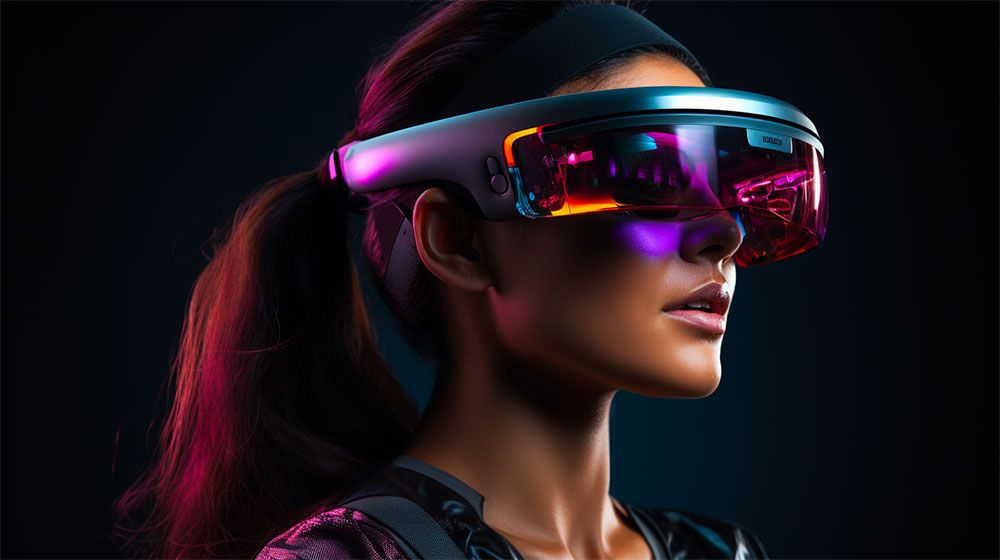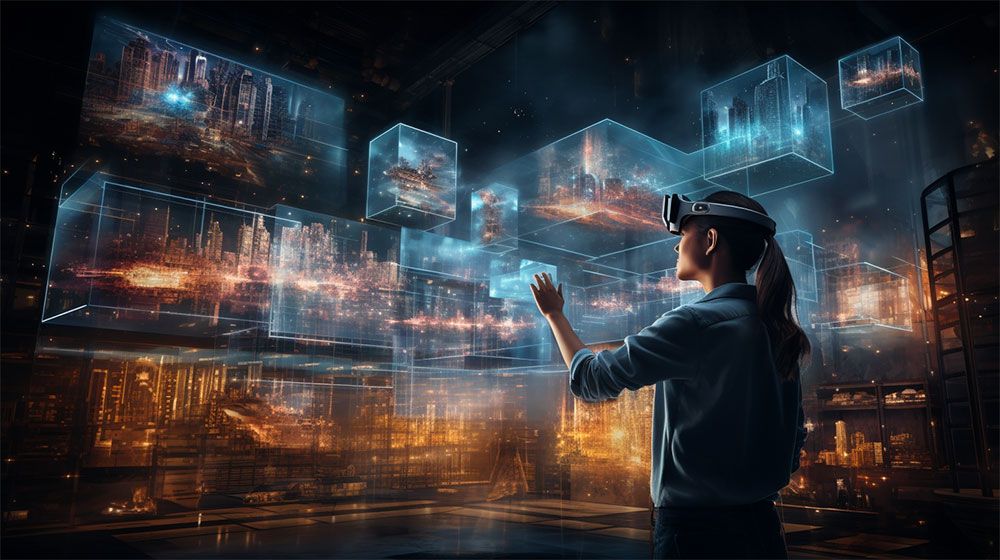Unlocking Reality: The Spatial Web's Transformative Impact

Although the hype around the metaverse has slowed down due to the new kid in town, generative AI, it does not mean that the immersive internet is not happening. As a futurist, I believe spatial computing is more than just a trend. It is making a big impact, from helping in complex surgeries to revolutionising education and manufacturing. Of course, there are challenges to tackle, like privacy concerns and user experience. But with innovation, we are making progress.
Looking ahead, spatial computing's potential seems limitless. Collaborative virtual workspaces can unite teams globally, and personalised augmented reality experiences will become the norm.
So, get ready for an exciting journey into the world of spatial computing, where reality and the digital world come together. Let's unlock its potential and create a future where anything is possible.
Understanding Spatial Computing
Spatial computing is a transformative technology that seamlessly intertwines our physical reality with the digital sphere, forging a new and profound connection. This cutting-edge approach is founded on the crucial concept of spatial awareness, granting computers the capacity to interact with the world in a manner more akin to human intuition. With its ability to bridge the physical and digital worlds, spatial computing presents many opportunities for businesses, industries, and individuals.
To better grasp the significance of spatial computing, let's explore a few key points that shed light on its understanding and potential applications:
- Spatial computing is an emerging technology that blends the physical and digital worlds, creating an immersive and interactive user experience.
- Spatial computing relies on sensors, cameras, and advanced algorithms to understand and map the user's environment in real-time.
- By seamlessly integrating digital components into the real-world environment, spatial computing enables users to interact with digital content seamlessly, leading to applications ranging from gaming and entertainment to remote collaboration and education.
Essentially, spatial computing encompasses diverse technologies, such as augmented reality, virtual reality, mixed reality, and holographic interfaces. These practical innovations work in tandem to overlay digital information onto the physical environment or immerse users in virtual experiences. This fusion of technologies relies on advanced sensors, cameras, and computer vision algorithms, enabling real-time recognition and interpretation of the physical space around us to flawlessly integrate digital content.
The Spatial Web

The Spatial Web, a seminal work authored by renowned futurist and technologist Gabriel René, whom I interviewed for my book Step into the Metaverse, is an excellent resource for understanding the spatial computing revolution. This influential book delves into the concrete potential of spatial computing, exploring how it can revolutionise various industries like healthcare, education, design, entertainment, and beyond.
The practical insights within its pages shed light on the transformative power of spatial computing, providing a glimpse into the future where real-world applications can harness this technology's capabilities for tangible benefits.
In today's context, The Spatial Web serves as a guiding beacon for businesses and individuals seeking to understand the capabilities of spatial computing and how it can be harnessed to create a more immersive and efficient digital experience. René's vision for the spatial web encompasses a future where our interactions with the digital world are intuitive, natural, and seamlessly integrated into our daily lives, revolutionising how we work, play, and communicate.
Spatial computing offers the ability to seamlessly integrate the digital world with the physical environment. The technology's potential to enhance productivity, improve customer experiences, and streamline operations make it an attractive prospect for forward-thinking organisations.
As the potential of spatial computing becomes increasingly evident, organisations across various sectors are eagerly embracing this transformative technology. Companies recognise the immense value of spatial computing in enhancing productivity, creating unique customer experiences, and gaining a competitive edge in the market. According to a report by the International Data Corporation (IDC), worldwide spending on augmented reality and virtual reality is projected to reach $72.8 billion by 2024, signifying the growing interest and adoption of spatial computing technologies.
Industries heavily relying on design and visualisation, such as architecture, interior design, and automotive, are particularly enthusiastic about spatial computing's ability to revolutionise their processes. Architectural firms are leveraging augmented reality to present virtual walkthroughs of unbuilt structures to clients, revolutionising how designs are communicated and approved.
Exploring Spatial Computing: Applications and Technologies

Many companies have already embraced spatial computing technologies and are actively using them in various applications. For example, Microsoft has been a major player in the spatial computing space with its HoloLens and Windows Mixed Reality platform. HoloLens is an advanced AR headset that overlays digital holograms onto the user's physical environment, enabling applications in fields like industrial design, training, and remote collaboration.
Google, on the other hand, made significant strides in spatial computing with its ARCore platform. ARCore is an innovative platform that brings augmented reality experiences to Android devices, empowering developers to create compelling and interactive AR applications for a vast user base. The device's camera, motion sensors, and computing power enable ARCore to accurately map the environment to seamlessly interact with the real world, enriching users' everyday experiences with an array of imaginative and practical applications.
Apple has, of course, entered the spatial computing arena with ARKit, a powerful framework for developers to create augmented reality experiences on iOS devices. The company invests heavily in AR, with features like AR Quick Look and AR navigation integrated into its devices. More importantly, the recent announcement of the Apple Vision Pro marks a revolutionary milestone as Apple's first significant product since the Apple Watch in 2014. The headset's powerful cameras and sensors create a remarkable fusion of reality and virtual elements, showcased through high-definition screens positioned millimetres from the user's eyes. Anticipating its official launch in 2024 at a price point of $3,499, Apple has already opened applications for Vision Pro developer's kits, inviting developers to explore and shape the limitless possibilities of this immersive technology.
Finally, Meta has been a major player in betting on the spatial web since Mark Zuckerberg changed the company name to Meta. Their Quest devices hold vital importance as they allow users to immerse themselves in fully virtual environments, erasing the boundaries between the physical and digital worlds. Beyond appealing to gamers, these devices find increasing application in training and education, showcasing their relevance in shaping the interconnected future of spatial computing. Meta is crucial in promoting the revolutionary potential of the spatial web by bridging the divide between users and virtual places.
These are just a few examples, and many other companies across various industries are exploring and integrating spatial computing technologies into their products and services to enhance user experiences, improve efficiency, and drive innovation.
The growing ecosystem of spatial computing tools, development platforms, and hardware will further fuel this trend, enabling more businesses to leverage these technologies and unlock their potential for creating meaningful and practical applications.
As a result, the future landscape of industries is poised to be reshaped by spatial computing as companies strive to stay competitive and cater to the ever-evolving expectations of their audiences. Exciting times lie ahead as spatial computing transforms from a promising innovation to a pervasive and integral part of our daily lives.
The Transformative Influence of the Spatial Web on Organisations

The emergence of the Spatial Web is poised to profoundly impact organisations across diverse industries, ushering in a new era of opportunities and challenges. As this interconnected digital ecosystem becomes more prevalent, businesses must proactively understand and embrace the Spatial Web to stay ahead of the curve and thrive in the fast-evolving technological landscape. To underscore its significance for organisations, the following aspects come into focus:
- Adopting Spatial Computing fosters innovation and opens up new avenues for product and service development. Organisations can experiment with novel concepts, such as mixed reality experiences, spatial interfaces, and interactive content, to differentiate themselves in the market and stay ahead of the competition.
- Organisations must also consider the ethical implications of Spatial Computing. As this technology blurs the lines between reality and digital experiences, it raises questions about data ownership, digital consent, and the potential for addiction or dependency on immersive technologies. Striking a balance between innovation and responsible usage is crucial to mitigate potential risks.
The emergence of Spatial Web technology promises an extraordinary impact on organisations, reshaping their long-term operations with remarkable efficiency and productivity gains. The Spatial Web revolutionises how teams collaborate, breaking down geographical barriers and enhancing communication across different locations. With the integration of virtual meeting spaces and augmented reality collaboration tools, organisations can conduct remote meetings, design sessions, and training workshops in realistic virtual environments.
This transformation in communication and collaboration enables companies to assemble diverse teams of experts from around the world, fostering greater creativity and knowledge exchange. It also enhances employee productivity by minimising travel requirements and facilitating seamless information sharing.
The Spatial Web empowers organisations to process and analyse vast amounts of data through immersive data visualisation. Complex datasets can be represented spatially, enabling executives and decision-makers to understand trends, correlations, and patterns more intuitively. This newfound ability to visualise data in three-dimensional space enhances strategic decision-making and helps companies identify untapped opportunities and potential risks. From urban planning to supply chain management, the Spatial Web enables organisations to make informed decisions and optimise operations with unparalleled precision.
Obtain Deeper Insights in 3D
Exploring data in a three-dimensional space enables companies to gain deeper insights and make more strategic decisions. For instance, in retail, a 3D data exploration platform allows businesses to immerse themselves in a virtual representation of their store, analysing real-time data on customer foot traffic, sales performance, and behaviour patterns. Decision-makers can roam through the virtual environment, identify high-traffic areas, experiment with product placements, and observe how layout changes impact customer interactions and sales. This enhanced visualisation empowers companies to identify untapped opportunities and potential risks, leading to more informed and data-driven strategies.
Decision-makers can acquire a thorough understanding of their operations and market dynamics by placing data in a three-dimensional context, allowing them to go beyond conventional two-dimensional charts and graphs.
The Spatial Web's influence goes beyond the boardroom, revolutionising employee training and skill development through interactive and realistic simulations, propelling teams into a culture of perpetual learning and adaptability. Customer engagement takes on a whole new dimension as organisations create augmented reality experiences that provide customers with a tangible and personalised connection to products, engendering unwavering loyalty and satisfaction.
In marketing and branding, spatial computing paves the way for innovative and engaging campaigns that set brands apart, strengthening their identity and recognition. A forward-thinking approach safeguards organisations against future uncertainties, enabling them to ride the crest of technological advancements and remain at the forefront of their industries.
The Spatial Web and Digital Twins
In addition, digital twins and the spatial web form a captivating alliance, merging the fields of data and imagination. Digital twins are exact virtual replicas of real-world objects or systems infused with real-time data and simulations, offering profound insights into their physical counterparts. On the other hand, the spatial web blurs the lines between the physical and digital worlds, creating an interconnected environment where virtual elements blend seamlessly with reality.
As digital twins seamlessly merge with the spatial web, users are granted immersive and intuitive access to these virtual replicas, unlocking fascinating possibilities like remote monitoring, interactive simulations, and predictive analytics. This powerful fusion marks the dawn of a new era, reshaping how we understand and interact with our surroundings.
In short, with its practical and transformative attributes, the Spatial Web offers organisations a ticket to unparalleled growth and success in an ever-evolving digital landscape. With the power of spatial computing at their fingertips, organisations are poised to transcend limitations, unlocking a world of possibilities that propel them toward the top of their aspirations.
How the Spatial Web Will Affect Industries

The spatial web represents a monumental shift for industries and organisations across all sectors. As virtual, augmented and mixed reality technologies become more immersive, integrated and accessible, they will transform how businesses operate, engage customers and visualise data.
As such, spatial computing has the potential to revolutionise workflows, provide new revenue opportunities and redefine competitive advantages. Organisations that embrace spatial technologies early will be best positioned to capitalise on the benefits of enhanced operations, experiences and insights. Let's dive deeper into how the spatial web will change industries.
Retail and Marketing Industry and the Spatial Web
A study by PwC shows that spatial computing is also transforming consumer behaviour. The research indicates that 46% of consumers have used AR to preview products before purchase, while 43% have expressed a willingness to pay more for a product if they could experience it through AR.
Customer experiences are at the heart of any successful business, and the Spatial Web redefines the possibilities for engaging and immersive interactions. Augmented, virtual, and mixed reality applications enable organisations to craft unforgettable experiences that cater to individual preferences and needs. For example, Nike embraces cutting-edge technology by utilising augmented and virtual reality to elevate the shopping experience in their physical stores.
The Spatial Web elevates customer engagement to unprecedented levels, from interactive product demonstrations and virtual showrooms to personalised marketing campaigns that adapt to users' real-world environments. As consumers increasingly seek immersive and tailored experiences, businesses that embrace the Spatial Web will have a distinct advantage in winning over their audience.
Healthcare Industry and the Spatial Web
Spatial computing is set to drive a profound transformation in the healthcare industry with its transformative applications. From empowering immersive medical training and surgical planning to facilitating augmented patient education and remote consultations, spatial computing technologies like augmented and virtual reality promise to enhance precision, elevate patient outcomes, and optimise operational workflows. Harnessing the potential of spatial computing, the healthcare sector stands on the precipice of a remarkable evolution, ushering in a new era of patient-centric care and innovative medical practices.
Spatial computing in healthcare has led to advanced VR tools being used at George Washington University for neurosurgery and thoracic surgery. Surgeons can virtually explore a patient's brain and body, enhancing surgical efficiency and patient understanding. Also, a Harvard Business Review study from 2019 found that VR training improved surgical performance by 230% compared to traditional methods. These applications highlight the transformative impact of spatial computing in healthcare.
The Spatial Web and the Education Industry
Spatial computing has emerged as a catalyst for educational transformation, infusing the learning experience with immersive and interactive elements. Through AR and VR applications, students can take virtual field trips to distant places, conduct hands-on experiments, and engage with personalised content that caters to their unique learning styles. Educators, too, benefit from spatial computing by refining their teaching techniques through virtual classrooms and professional development simulations. In addition, spatial computing fosters inclusivity in education, accommodating diverse student needs and facilitating remote learning opportunities.
Universities and colleges are increasingly integrating AR and VR into their curricula, often collaborating with technology companies and startups. For instance, at UC Berkeley, a DIY approach has emerged, utilising freely available content creation tools like Unity and 3D digitisation technologies such as photogrammetry. This has enabled students to create custom AR and VR experiences, offering novel educational opportunities, like exploring university museum collections through immersive remote experiences. Early adoption of AR and VR is particularly prevalent in disciplines with a keen interest in new visualisation technologies.
Embracing spatial computing in education promises a more dynamic, engaging, and inclusive learning environment, empowering students and educators alike to pursue knowledge and skills for the future.
Tourism Industry and Spatial Computing
Spatial computing has become a game-changer in the tourism industry, revolutionising how travellers experience and engage with destinations. Through AR and VR applications, tourists can embark on virtual tours, explore historical landmarks, and gain insights into cultural sites before setting foot on their journeys. On-site experiences are also enhanced as AR guides provide context-rich information and interactive elements, immersing visitors in the destination's heritage and stories.
In the tourism industry, companies like First Airlines are redefining travel experiences through immersive virtual reality "trips" to destinations like Hawaii, Rome, and Paris. With cutting-edge virtual reality technology, travellers can embark on virtual journeys to these iconic locations without leaving their home countries. These VR experiences provide an unprecedented level of immersion, allowing tourists to explore famous landmarks, picturesque landscapes, and cultural wonders as if they were physically present. This innovative approach to travel not only offers convenience and accessibility but also opens up exciting possibilities for travellers to experience new destinations and cultures in a whole new way.
Also, the hospitality sector leverages spatial computing to offer virtual room tours and VR-based concierge services, providing travellers with personalised and engaging experiences. This seamless integration of technology and exploration ushers in a new era of experiential travel, enriching visitor engagement and leaving lasting impressions that linger long after the voyage ends.
The Spatial Web is not merely a passing trend but a paradigm shift in how businesses operate, engage with customers, and shape their future. Embracing the Spatial Web is not just a competitive advantage; it is a strategic imperative for companies seeking to forge a path towards continued growth, innovation, and enduring success in the tech-driven world of tomorrow.
Main Challenges in Spatial Computing

In the ever-evolving landscape of technological advancements, the Spatial Web stands out as a beacon of transformative potential for organisations. However, alongside its promising possibilities, embracing this cutting-edge technology also entails navigating a set of unique challenges that demand careful consideration and strategic planning, including:
- Overcoming barriers to widespread implementation is crucial for organisations to maximise spatial computing's benefits.
- Managing the learning curve for employees and customers is essential to ensure a seamless adoption and utilisation of spatial computing tools and applications.
- Effectively integrating spatial computing with the Internet of Things (IoT) is a significant obstacle that businesses need to navigate for enhanced interconnected experiences.
The first challenge involves ensuring the seamless adoption of spatial computing technologies on a broader scale. Organisations must overcome technological limitations, make advanced hardware accessible and affordable, and establish standardised protocols for the interconnected network to create a cohesive Spatial Web experience.
The transition to spatially aware systems may present a learning curve for employees and customers alike. Companies must invest in comprehensive training and education programs to help their workforce adapt to new ways of working and interacting with spatial technologies. Designing user-friendly experiences is essential to encouraging widespread acceptance among customers.
Integrating spatial computing with the IoT opens exciting possibilities but also poses challenges related to data security, privacy, and scalability. Businesses must prioritise data protection and implement robust security measures to safeguard sensitive information. Also, we need to consider that managing the vast influx of data requires scalable infrastructure and advanced analytics capabilities.
However, these challenges are not impossible to overcome. Embracing the Spatial Web with a forward-thinking approach will empower organisations to stay ahead of the curve, drive innovation, and capitalise on its limitless potential. As we continue our exploration, we will delve into practical strategies and real-world examples of successful spatial computing implementation, guiding businesses towards a future where reality and imagination converge and the Spatial Web reshapes the technological landscape.
Future Outlook and Opportunities in Spatial Computing

The future of spatial computing and the Spatial Web looks remarkably promising, with projections indicating exponential growth in the coming years. Spatial computing technologies will likely become more extensive and deeply integrated into our daily lives within the next few years. For these reasons, it is imperative to focus on the following issues:
- As spatial computing becomes more prevalent, there will be an increased demand for skilled professionals specialising in spatial design, data analysis, content creation, and user experience optimisation.
- With the growth of spatial computing, there will be a surge in innovation and the development of new applications and technologies, leading to a dynamic and competitive landscape in the tech industry.
The global spatial computing market, which includes AR, VR, and MR technologies, is expected to reach $516.2 billion by 2032, owing to advancements in hardware and software as well as rising demand for immersive experiences.
Spatial computing will fuel innovation, allowing businesses to engage customers through immersive advertising and redefine entertainment with interactive experiences. Education will evolve with virtual classrooms, and social interactions will transcend geographical barriers in shared virtual spaces. As spatial computing matures, organisations that embrace innovation and explore new business models will thrive in this transformative landscape.
The Era of Spatial Computing is upon us, and it presents a transformative frontier that will redefine how we interact with technology, experience reality, and conduct business. With the convergence of augmented, virtual, and mixed reality, the Spatial Web is weaving a rich pattern of possibilities beyond our imagination.
From enhancing customer engagement and revolutionising industry operations to creating new business models and job roles, spatial computing holds the potential to shape every aspect of our lives.
Moving beyond its current gaming applications, spatial computing can facilitate shared experiences that transcend physical boundaries. For instance, a hypothetical scenario includes people from across the globe participating in concerts, theatrical performances, and various social gatherings in a virtual realm, fostering a sense of genuine connection and immersion. As spatial computing advances, it will likely reshape how we perceive and engage with the world, opening up new frontiers for human communication and collaboration.
With that said, organisations and individuals alike must embrace this technological revolution with an open mind and a proactive spirit. Understanding the challenges and opportunities that come with the Spatial Web will empower businesses to navigate this uncharted territory successfully. Organisations must adopt a forward-thinking approach, investing in research, talent development, and cutting-edge technologies to stay ahead in this rapidly evolving landscape. Embracing the potential for innovation and creativity will be the driving force that propels businesses to thrive in this new era.
The journey has just begun, and the potential for transformative impact is unprecedented. Let's embrace the Era of Spatial Computing together as we shape a future where technology enhances our lives and enriches our understanding of the world and our place in it.
Final Thoughts
The spatial computing era promises to be a thrilling chapter in the ongoing story of technological advancement. As this cutting-edge technology gains momentum, it holds the potential to transform the way we interact, socialise, and collaborate. Beyond its initial gaming applications, spatial computing can bring people closer together in a shared digital realm, erasing the limitations of physical distance. Concerts and performances could be experienced from the comfort of one's own home, and everyday social gatherings could transcend borders and time zones. However, with these exciting possibilities come important considerations, such as privacy, security, and the need for responsible usage.
To start embracing the spatial web, organisations can begin by researching and understanding its concepts, identifying relevant use cases, and assessing their technology readiness. They should pilot projects, collaborate with experts, and develop internal expertise in spatial computing. Prioritise user experience, address data security and privacy and gather user feedback for continuous improvement. Gradually scale up spatial web solutions, measure its impact with KPIs, and stay updated on advancements in the field to harness the spatial web's transformative potential across various aspects of its operations.
As we journey into the world of spatial computing, it will be essential to strike a balance between innovation and ethical implementation. As with any technological advancement, the responsible development and integration of spatial computing will determine the extent of its positive impact on society. Let’s embrace this era with optimism and a commitment to using this powerful tool to enhance human connection and forge a more united and immersive global community. The future of spatial computing beckons, and it is up to us to shape it for the betterment of all.
Images: Midjourney





